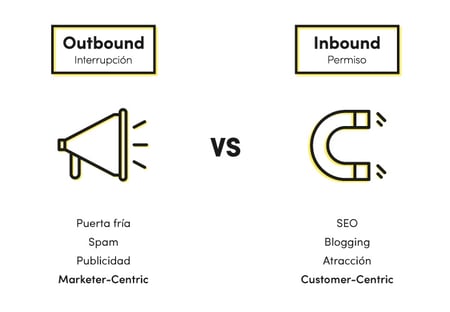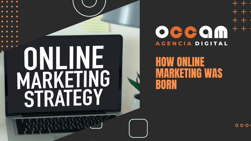Index Content
Although some people think that outbound marketing is set to disappear in the digital age, the truth is that there are many more voices calling for combining traditional marketing strategies with inbound marketing strategies for better results.
what is Outbound marketing?
Outbound Marketing is traditional marketing based on a set of actions whose main and final objective is to sell products or services to users. It is a type of unidirectional marketing, that is, communication always starts from the company to the user. Its main characteristics are:
- It focuses on the brand and the product or service, i.e. the customer is secondary and the product or service is the main thing.
- It tries to attract the attention of customers through the most traditional means, for example, it uses the press, television, radio or posters in the offline world .
- Communication is unidirectional: the company or brand communicates its message to the public and there is no interaction between the two. The company does not seek the public's response, it launches its message and expects them to carry out the desired action, which is none other than the purchase or contracting of the advertised product or service.
- The focus of outbound marketing is totally commercial .
- It is difficult to measure. Its channels and its massive way of launching its message make it difficult to measure the results.
- Outbound marketing does not segment its audience, so it can be impersonal because it tries to reach everyone at the same time and this can mean that it ends up not reaching anyone.
Advantages of Outbound marketing
- Direct: The communication of this strategy makes it clear from the beginning what it wants you to do as a user: "Look", "click", "buy", all the messages have the product or service as the main character.
- Message received: The communication is the same for everyone, no one is excluded, the important thing is the reach, you do not care about establishing communication with your customers.
- Urgent and short: Outbound does not have patience, it conveys a sense of urgency, that the customer has to buy immediately.

what are the differences between Outbound and Inbound marketing?
- The main difference between these two concepts is centred on the objective of each version of marketing: while Inbound aims to get you to consume advertising content, Outbound aims to sell.
- Another fundamental difference is the channel used by both: Inbound is more modern and uses digital methods such as websites or social networks, while Outbound is more traditional, preferring channels such as radio, television or newspapers and magazines, although it is also present on websites .
- Communication is another characteristic that differentiates these two marketing siblings: while Inbound is based on interactive and bidirectional communication, Outbound is unidirectional, it issues information without waiting for the customer's reaction.
- The mediation of results is another point to take into account. Inbound marketing personalises its content because it knows its audience perfectly well, using digital tools it can check whether it is doing it right or wrong. On the other hand, Outbound marketing is more impersonal, it does not know who it is targeting because all it wants is for everyone to see the image of the product or service.

how do you successfully execute an Outbound marketing strategy?
- combining digital campaigns with offline campaigns: they are not mutually exclusive and online and offline campaigns can be carried out with a common message and language .
- sEM campaigns: SEM tries to position the brand in one or several search engines (e.g. Google, Yahoo, Bing...) through the use of paid and optimised advertising. By combining Outbound marketing and Inbound marketing you can reach a large number of people with certain keywords. The message can be one-way, commercial and direct but the segmentation that these tools allow will make it reach the people interested in them. And, in addition, it does so at the time when they show interest in the keywords that have been previously determined.
- through advertisements on social networks. In principle, social networks are two-way media, but advertisements on them do not have to be. The message will reach users but it does not even have to go through a corporate profile on that network if you do not want it to, although it can .
- using banners and videos: Banners and video ads can be very effective, but to get a good ROI it is important to do it carefully. You can get a good return on investment as long as the message is appealing, it is well placed within the page and the medium is appropriate for the message you want to send .
Finally, remember that by working with joint strategies of Outbound marketing and Inbound marketing you can combine ads on social networks with corporate presence through profiles on them, use Google banners and SEM ads without neglecting SEO positioning.





